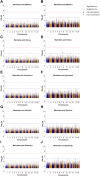A Genome-Wide Association Study and Machine-Learning Algorithm Analysis on the Prediction of Facial Phenotypes by Genotypes in Korean Women
- PMID: 35313536
- PMCID: PMC8933694
- DOI: 10.2147/CCID.S339547
A Genome-Wide Association Study and Machine-Learning Algorithm Analysis on the Prediction of Facial Phenotypes by Genotypes in Korean Women
Abstract
Purpose: Changes in facial appearance are affected by various intrinsic and extrinsic factors, which vary from person to person. Therefore, each person needs to determine their skin condition accurately to care for their skin accordingly. Recently, genetic identification by skin-related phenotypes has become possible using genome-wide association studies (GWAS) and machine-learning algorithms. However, because most GWAS have focused on populations with American or European skin pigmentation, large-scale GWAS are needed for Asian populations. This study aimed to evaluate the correlation of facial phenotypes with candidate single-nucleotide polymorphisms (SNPs) to predict phenotype from genotype using machine learning.
Materials and methods: A total of 749 Korean women aged 30-50 years were enrolled in this study and evaluated for five facial phenotypes (melanin, gloss, hydration, wrinkle, and elasticity). To find highly related SNPs with each phenotype, GWAS analysis was used. In addition, phenotype prediction was performed using three machine-learning algorithms (linear, ridge, and linear support vector regressions) using five-fold cross-validation.
Results: Using GWAS analysis, we found 46 novel highly associated SNPs (p < 1×10-05): 3, 20, 12, 6, and 5 SNPs for melanin, gloss, hydration, wrinkle, and elasticity, respectively. On comparing the performance of each model based on phenotypes using five-fold cross-validation, the ridge regression model showed the highest accuracy (r2 = 0.6422-0.7266) in all skin traits. Therefore, the optimal solution for personal skin diagnosis using GWAS was with the ridge regression model.
Conclusion: The proposed facial phenotype prediction model in this study provided the optimal solution for accurately predicting the skin condition of an individual by identifying genotype information of target characteristics and machine-learning methods. This model has potential utility for the development of customized cosmetics.
Keywords: customized cosmetics; genome-wide association study; machine-learning algorithm; microarray; single-nucleotide polymorphism.
© 2022 Yoo et al.
Conflict of interest statement
Hye-Young Yoo, Ji-Eun Woo, Sung-Ha Park, and Byoung-Jun Park are employees of Kolmar Korea Co., Ltd. Ki-Chan Lee, Sunghoon Lee, Joungsu Joo, Jin-Sik Bae, and Hyuk-Jung Kwon are employees of Eone Diagnomics Genome Center Co., Ltd. The authors report no other potential conflicts of interest in this work.
Figures



Similar articles
-
A machine learning pipeline for quantitative phenotype prediction from genotype data.BMC Bioinformatics. 2010 Oct 26;11 Suppl 8(Suppl 8):S3. doi: 10.1186/1471-2105-11-S8-S3. BMC Bioinformatics. 2010. PMID: 21034428 Free PMC article.
-
Evaluation of penalized and machine learning methods for asthma disease prediction in the Korean Genome and Epidemiology Study (KoGES).BMC Bioinformatics. 2024 Feb 2;25(1):56. doi: 10.1186/s12859-024-05677-x. BMC Bioinformatics. 2024. PMID: 38308205 Free PMC article.
-
Utilizing Deep Learning and Genome Wide Association Studies for Epistatic-Driven Preterm Birth Classification in African-American Women.IEEE/ACM Trans Comput Biol Bioinform. 2020 Mar-Apr;17(2):668-678. doi: 10.1109/TCBB.2018.2868667. Epub 2018 Sep 3. IEEE/ACM Trans Comput Biol Bioinform. 2020. PMID: 30183645
-
Biological function integrated prediction of severe radiographic progression in rheumatoid arthritis: a nested case control study.Arthritis Res Ther. 2017 Oct 25;19(1):244. doi: 10.1186/s13075-017-1414-x. Arthritis Res Ther. 2017. PMID: 29065906 Free PMC article.
-
Meta-analysis and prioritization of human skin pigmentation-associated GWAS-SNPs using ENCODE data-based web-tools.Arch Dermatol Res. 2019 Apr;311(3):163-171. doi: 10.1007/s00403-019-01891-3. Epub 2019 Feb 13. Arch Dermatol Res. 2019. PMID: 30756169 Review.
Cited by
-
From COVID-19 to monkeypox: a novel predictive model for emerging infectious diseases.BioData Min. 2024 Oct 22;17(1):42. doi: 10.1186/s13040-024-00396-8. BioData Min. 2024. PMID: 39438943 Free PMC article.
References
-
- Zhang Y, Jiang R, Kezele I, et al. A new procedure, free from human assessment, that automatically grades some facial skin signs in men from selfie pictures. Application to changes induced by a severe aerial chronic urban pollution. Int J Cosmet Sci. 2020;42(2):185–197. doi: 10.1111/ics.12602 - DOI - PubMed
LinkOut - more resources
Full Text Sources
Other Literature Sources

